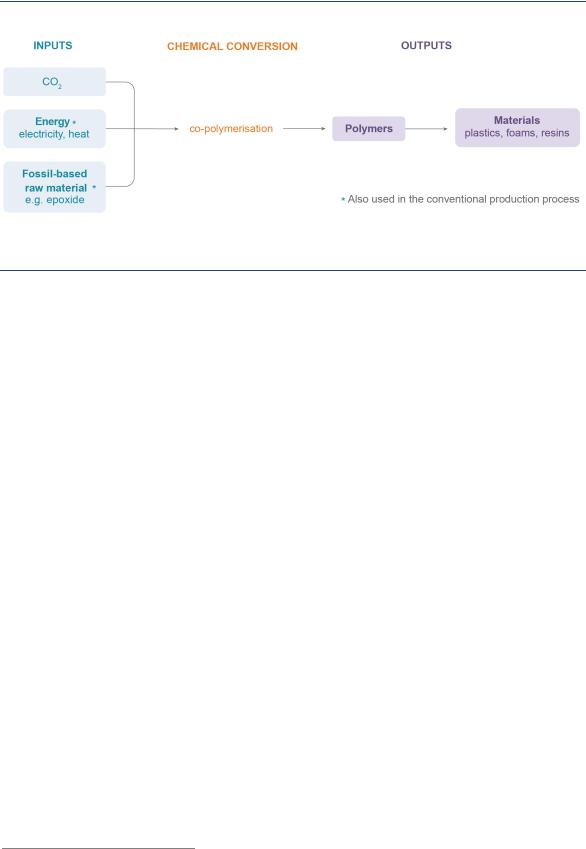
- •Putting CO2 to Use
- •Abstract
- •Highlights
- •Executive summary
- •CO2 is a valuable commodity
- •Early markets are emerging but the future scale of CO2 use is uncertain
- •Using CO2 can support climate goals, but with caveats
- •Cultivating early opportunities while planning for the long term
- •Findings and recommendations
- •Millions of tonnes of CO2 are being used today
- •New pathways for CO2 are generating global interest
- •CO2 use can contribute to climate goals, but with caveats
- •The future scale of CO2 use is highly uncertain
- •Where are the emerging market opportunities?
- •1. CO2-derived fuels
- •2. CO2-derived chemicals
- •3. Building materials from minerals and CO2
- •4. Building materials from waste and CO2
- •5. Crop yield boosting with CO2
- •CO2 use can complement CO2 storage, but is not an alternative
- •References
- •Policy recommendations
- •Technical analysis
- •Introduction
- •Setting the scene
- •What is CO2 use?
- •CO2-derived fuels
- •CO2-derived chemicals
- •CO2-derived building materials
- •Where is CO2 being used today?
- •What has spurred renewed interest in CO2 use?
- •Who is currently investing in CO2 use, and why?
- •How can CO2-derived products and services deliver climate benefits?
- •Understanding the future market for CO2-derived products and services
- •Which factors influence the future market?
- •Scalability
- •Competitiveness
- •The price and availability of hydrogen
- •The price and availability of CO2
- •Climate benefits
- •Origin of the CO2
- •Displaced product or service (reference system)
- •Energy input
- •Retention time of carbon in the product
- •Is it possible to assess the future market size?
- •Scaling up the market
- •CO2-derived fuels
- •What are CO2-derived fuels?
- •Are CO2-derived fuels scalable?
- •Under what conditions would CO2-derived fuels be competitive?
- •Can CO2-derived fuels deliver climate benefits?
- •What are the regulatory requirements?
- •CO2-derived chemicals
- •What are CO2-derived chemicals?
- •Are CO2-derived chemicals scalable?
- •Under what conditions would CO2-derived chemicals be competitive?
- •Can CO2-derived chemicals deliver climate benefits?
- •What are the regulatory requirements?
- •CO2-derived building materials from natural minerals
- •What are CO2-derived building materials?
- •Are CO2-derived building materials scalable?
- •Under what conditions would CO2-derived building materials be competitive?
- •Can CO2-derived building materials deliver climate benefits?
- •What are the regulatory requirements?
- •CO2-derived building materials from waste
- •What are building materials made from waste?
- •Are building materials from waste scalable?
- •Under what conditions are building materials from waste competitive?
- •Can building materials from waste deliver climate benefits?
- •What are the regulatory requirements?
- •CO2 use to enhance the yield of biological processes
- •What is yield boosting?
- •Is CO2 yield boosting scalable?
- •Under what conditions is CO2 yield boosting competitive?
- •Can CO2 yield boosting deliver climate benefits?
- •What are the regulatory requirements?
- •Where are suitable locations for an early market?
- •Implications for policy
- •Public procurement
- •Mandates
- •Economic incentives
- •Labelling, certification and testing
- •Research development and demonstration
- •Recommendations
- •References
- •General annex
- •Abbreviations and acronyms
- •Acknowledgements
- •Table of contents
- •List of figures
- •List of boxes
- •List of tables

Putting CO2 to Use: Creating Value from Emissions |
Technical analysis |
What are the regulatory requirements?
Fuel quality standards specifying technical requirements for transport fuels may currently limit the use of CO2-derived fuel. For example, most fuel quality standards worldwide restrict methanol blends with fossil gasoline for use in conventional car engines to several per cent by volume (Alberici et al., 2017). Fuel testing and warranties from engine manufacturers are needed before novel fuels can be earmarked as suitable and can be compatible with the existing infrastructure of road or aviation transport.
Table 3. Scaling up to a 10 MtCO2 market for CO2-derived fuels
|
Technology |
|
No major technological breakthroughs needed. |
||
|
|
|
|
|
|
|
|
|
|
The fuel market is large enough to absorb well in excess of 7.3 Mt of methanol or |
|
|
Scalability |
|
|
3.6 Mt of methane, which would each correspond to the conversion of 10 Mt CO2/yr. |
|
|
|
|
Significant amounts of low-carbon energy are required. |
|
|
|
|
|
|
|
|
|
|
|
|
Production capacity for fuels and low-carbon hydrogen is needed. |
|
|
|
|
|
|
|
|
|
|
|
CO2-derived fuels are currently not competitive with fossil fuels in most regions of |
|
|
Competitiveness |
|
the world, nor with many other alternative energy carriers, such as the direct use of |
||
|
|
electricity and hydrogen. |
|||
|
|
|
|
||
|
|
|
|
Low-cost renewable energy and CO2 are prerequisites. |
|
|
|
|
|
|
|
|
|
|
|
Low-carbon hydrogen is essential to achieve climate benefits. |
|
|
Climate benefits |
|
|
Emissions reductions of up to 90% relative to convention fuels have been reported, |
|
|
|
|
|
but verification is needed. |
|
|
|
|
|
Fuel quality standards restrict methanol blends with gasoline. |
|
|
Regulation and |
|
Extensive fuel testing and warranties from engine manufacturers are needed. |
||
|
other issues |
|
Some emission standards are based on tailpipe emissions rather than on life-cycle |
||
|
|
|
|
emissions. |
|
CO2-derived chemicals
What are CO2-derived chemicals?
CO2-derived chemicals include a wide range of carbon-containing substances, including plastics, fibres, solvents and synthetic rubber. CO2 is used as a raw material to produce a number of intermediate chemicals, which can then be processed into an array of more complex chemicals. These intermediate chemicals – e.g. ethylene, propylene and methanol – are produced in large volumes and can also be finished products in themselves. Of the intermediate chemicals that can be created from CO2, the production process of methanol and methane is most technologically mature and can serve as a source for various other intermediate chemicals.
The two most important intermediate chemicals that can be derived from methanol are olefins (e.g. ethylene, propylene), which are widely used in the production of polymers to manufacture plastics, and aromatics (e.g. benzene, toluene, xylene), which are used for the production of plastic, but are also used in health and hygiene, food production and processing, information technology and other sectors. Methanol-to-olefins technology is currently deployed at commercial scale in China, accounting for 9 million tonnes per year (Mt/yr) or 18% of domestic high value chemicals production in 2018 (IEA, 2019a). Methanol- to-aromatics, which is used to produce more complex HVC molecules, is currently still in the
PAGE | 48
IEA. All rights reserved.
Putting CO2 to Use: Creating Value from Emissions |
Technical analysis |
demonstration phase (IEA, 2018c). Other production pathways, such as oxidative methane coupling, which involves a reaction between oxygen and methane into higher value chemicals, are in even earlier stages of development.
The amount of energy that must be added to convert CO2 varies significantly per type of chemical. In general, producing chemicals from CO2 that are rich in oxygen or contain a socalled carbonate group (CO3) requires much less energy than producing olefins and paraffins (for example methane) that only contain carbon and hydrogen. Furthermore, several conversion routes result in a mix of different substances, meaning that a lot of energy needs to be added to separate the CO2-derived chemical from other substances (Artz et al., 2018). Examples of chemicals with a CO3 group are sodium carbonate (soda ash) and sodium bicarbonate (baking soda) – valuable chemicals for glass manufacture, cleaning agents and detergents – which can be manufactured from CO2 and underground aqueous salt solutions (brine), seawater or salt (NaCl). The chemical process often involves electrolysis to convert the salt-containing substance into a solution of sodium hydroxide. This solution is then reacted with CO2 to produce soda ash or baking soda. Several companies are active in using captured CO2 to produce soda ash and baking soda today. The two largest companies are Carbon Free Chemicals (Skymine® process) and Searles Valley Minerals (Carbon Free Chemicals, 2019; Searles Valley Minerals, 2019). Another example of a company active in this field is Carbon Clean Solutions, which annually captures 60 ktCO2 from a coal-fired power station near Chennai, India. The captured CO2 is used by Indian firm Tuticorin Alkali Chemicals and Fertilizers for soda ash production (Alberici et al., 2017).
Polymers are a special group of chemicals that are used in the production of plastics and resins. CO2 can be used in the manufacturing process by replacing part of the fossil-based feedstock (Figure 25). The most mature and widely pursued variant for CO2 use is polycarbonate, which can contain up to 50% CO2 by weight. Unlike the conversion of CO2 to fuels and intermediate chemicals, the use of CO2 in polymer manufacturing does not require significant energy input for the conversion process itself. The energy for conversion is provided by the fossil feedstock – so-called epoxides – in the polymer molecule that is not replaced by the CO2. A number of companies, such as Asahi Kasei Chemicals, Chi Mei Corp and Covestro, are commercially producing polymers using CO2 (Fukuoka et al. 2007; Covestro, 2018). CO2-derived chemicals, such as formic acid, dimethyl ether, formaldehyde and acetic acid, are still in the early stages of development, but may prove promising in the long term (CarbonNext, 2017). Other future opportunities are related to the production of novel materials such as carbon nanofibers (e.g. graphene) using CO2 from air in electrochemical processes (SAM, 2018). However, this pathway is dependent on wider evolution of markets for such materials. The technology is at very early stages of RD&D.
The main value proposition of CO2-derived chemicals is the provision of a carbon-containing chemical with lower costs and/or a lower environmental impact than their fossil equivalents. Some chemical feedstocks cannot be decarbonised as the carbon is inherent in providing its structure and properties. Apart from biomass and waste, CO2 is one of the few carbon building blocks that can be used as an alternative raw material for carbon-containing chemicals.
PAGE | 49
IEA. All rights reserved.

Putting CO2 to Use: Creating Value from Emissions |
Technical analysis |
Figure 25. Mature conversion pathways for CO2-derived polymeric materials
IEA 2019. All rights reserved.
CO2 can be converted into polymers, which can be used in a wide variety of products.
Are CO2-derived chemicals scalable?
The large size of the market for carbon-containing chemicals represents an important opportunity for CO2-derived chemicals, especially because of the need to reduce the use of fossil feedstocks. A large share of these organic chemicals can be produced by using CO2-derived methanol as a chemical building block.
Recent data on the global market size of baking soda and soda ash is limited, but is estimated to be around 2.5 Mt/yr and 55 Mt/yr, respectively (Merchant Research & Consulting, 2015; Alberici et al., 2017). To fulfil the global annual demand with CO2-derived soda carbonates, some 0.7 MtCO2 (baking soda) and 12.0 MtCO2 (soda ash) would be required.14
CO2-derived polycarbonates can replace their fossil counterparts, which are usually further processed into other polymers. A promising application of polycarbonates is in the upgrading to polyurethane, which is used in foams, coatings and other products. The global market for polyurethane is expected to reach 22.0 Mt in 2018, based on a compound annual growth rate of 7.5% between 2015 and 2020 (MRS, 2016). Over time, early stage applications of CO2 use in polycarbonates may open up new markets, such as elastomers, rubbers and coatings.
There are no technical constraints to produce 3.6 Mt of methanol or 20 Mt of polyurethane,15 which would individually correspond to the use of 10 Mt of CO2. As for the fuel market, significant amounts of low-carbon electricity would be required for the production of CO2- derived methanol. Producing all primary chemicals from CO2 would have large implications in terms of energy and raw material requirements (Box 7). 16
14Based on a CO2 use rate of 0.26 tCO2 per tonne of baking soda and 0.21 tCO2 per tonne of soda ash.
15The market for polyurethane is just large enough to absorb 10 Mt of CO2-derived polycarbonates. If needed, other polymer
markets can absorb polycarbonates as well.
16 “Primary chemicals” is the collective term for ammonia, methanol, olefins and aromatics.
PAGE | 50
IEA. All rights reserved.

Putting CO2 to Use: Creating Value from Emissions |
Technical analysis |
|
|
|
|
Box 7. Producing all primary chemicals from CO2: how much electricity and raw materials would be needed?
The substitution of fossil fuels with CO2 as a raw material for chemicals production entails the consumption of considerable amounts of resources. Many process routes require significant energy to generate hydrogen for the transformation of CO2, particularly where electrolysis is used. In addition to electricity, water and CO2 are needed for the production of CO2-derived chemicals.
The IEA carried out a thought exercise, or “what if” analysis, in order to get a sense of the order of magnitude of the CO2, electricity and water needs to meet primary chemical demand in the future. Primary chemicals is the the collective term for ammonia, methanol, olefins and aromatics. In this exercise, methanol and ammonia are made from electrolytic hydrogen and used as a chemical building block to produce an array of end-use chemicals. The analysis was not part of a scenario, but was undertaken as a separate exercise.
To fulfil the global primary chemical demand, some 1.4 GtCO2 would be required in 2030. If primary chemicals sourced from the refining sector are also included, this figure would further rise to approximately 2.3 GtCO2. To put these quantities into perspective, the combined direct CO2 emissions of energy-intensive industries, excluding the chemicals sector, are projected to make up around 4.2 GtCO2 by 2030 in the CTS (IEA, 2018c).
Approximately 11.7 petawatt hour (PWh) of electricity is required in 2030, of which approximately 75% is consumed by electrolysers for the production of hydrogen. The remainder is primarily used to convert methanol into end-use chemicals. If primary chemicals sourced from the refining sector are also included, some 17.4 PWh are required by 2030. To put these figures into perspective, the current global electricity generation is 26.7 PWh, while the projected electricity consumption for the industrial sector is 1.6 PWh by 2030 in the CTS (IEA, 2018c). A complete shift to a CO2-based global primary chemical supply would therefore require many times the 2 336 gigawatts (GW) of currently installed global renewable generation capacity, especially because many renewable power technologies have low utilisation factors. At the same time, the electrification of the primary chemicals supply could represent an opportunity to enhance flexibility in the electricity grid. The large fleet of electrolysers could be used to reduce load (ramping down) or absorb surplus supply of electricity (ramping up).
In addition to very large increases in global electricity demand, replacing fossil feedstocks for chemicals production with CO2 would have a significant impact on water consumption. In the “what if” analysis, feedstock water consumption for the production of primary chemicals is 2.2 Gt, which is around three and a half times greater than in the CTS in 2030. The high water intensity of CO2-derived chemicals could be a constraint for areas with limited water availability. A careful selection of the location for electricity-based hydrogen production capacity would therefore need to consider access to local water resources. The use of sea water as a feedstock for electrolysis could help avoid water stress issues, provided this technology could be further developed and become cost effective. Water desalination and purification is another way to make use of sea water and avoid any contribution to water stress issues, but is an energyintensive process in itself.
PAGE | 51
IEA. All rights reserved.
